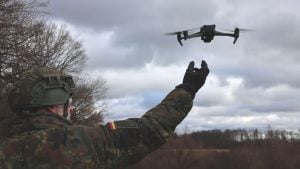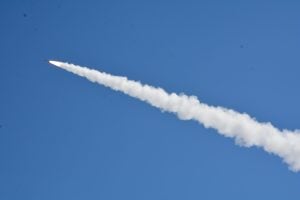Visit of Vice Chief of Air Staff to Forward Bases in Ladakh Region
- Vice Chief of Air Staff, Air Marshal Harjit Singh Arora PVSM AVSM ADC on 07 Aug 2020 visited forward air bases in Ladakh sector of Western Air Command (WAC).
- Besides reviewing the operational preparedness at these bases, the VCAS interacted with air warriors of the combat units currently operating at these locations.
- He was briefed about the operational readiness of IAF assets deployed in the area. He urged all air warriors, NCs(E), DSC personnel and Civilian staff to continue discharging their duties with utmost sincerity and ensure a high state of combat readiness at all times.
- During the visit he also flew Chinook and Light Combat Helicopter.
COAS visits Surya Command
- General MM Naravane, COAS, visited Surya (Central) Command and reviewed the operational preparedness. He complimented all ranks for high standards of operational preparedness & devotion to duty.
- The Central Command of the Indian Army is one of the seven operational commands of the army. It is based at Lucknow, Uttar Pradesh. Lt General Iqroop Singh Ghuman is the present General Officer Commanding-in-Chief.
- With its HQ at Lucknow the Command was re-established on 1 May 1963 due to the Sino-Indian War of 1962. Lt Gen K Bahadur Singh was the first Army Commander of the new Central Command. Prior to that date Lucknow had been the headquarters of the Eastern Command.
Nepal starts construction of helipad on disputed border area in Bihar
- Even before the administration could act on intelligence reports, the Nepal government has begun construction of a helipad at a disputed location on the Indo-Nepal border along West Champaran district of Bihar, officials said Thursday.
- The helipad is nearing completion at Narsahi village, a short distance from Thari border outpost (BOP) of Sashastra Seema Bal (SSB) near Valmiki Tiger Reserve (VTR) in West Champaran district, 80 km from Bettiah, headquarters of West Champaran district.
- “To the best of our knowledge, construction of the helipad meant for small choppers started a few days back on the disputed area,” said Commandant Rajendra Bhardwaj of 21st Sashastra Seema Bal (SSB) Battalion.
- On August 4, Nepal was planning to construct a helipad at Narsahi village which is a disputed land on Indo-Nepal border and a tender for which had been floated. The SSB had updated the headquarters about the development.
- However, much to their amazement, SSB officials on Thursday came across the construction of a circular cemented structure at Narsahi village. “We are trying to gather the other related information such as the total area of the helipad and the date on which it came up,” said the commandant.
- “The construction is at a disputed location. We will update the headquarters with photographs and other details,” said commandant Bhardwaj.
- Officials blame the changing course of the Gandak river for the controversy around Narsahi. SSB officials said the central part of the Gandak river forms the international boundary between Nepal and India. But with the river changing its course in the 1970s, Narsahi shifted to the other side of the river and later the Indian citizens living there moved to this part of the Indian territory.
- A video clip of the site shows the construction with a yellow border around it at a place near an agricultural field. Bricks and water tanks are seen lying on the site and pieces of iron rods and wet ground point it to be newly constructed.
- The development comes after the relationship between India and Nepal has become strained particularly after the latter’s Parliament approved a new political map, claiming Lipulekh, Kalapani and Limpiadhura in Uttarakhand as its territory.
- There are also speculations about the proposed construction of two more helipads along the Indo-Nepal border. These include one at Triveni near Valmikinagar (West Champaran) and other in Ujjaini (Nawalparasi district of Nepal) sharing border with Uttar Pradesh.
- “There is a concentrated effort being made by a handful of KP Sharma Oli supporters to provoke us whereas a larger section of the Nepalese are in favour to protect their age-old relationship with us. It is high time when New Delhi should break its silence and do the needful,” said Mahesh Agrawal, president of Seema Jagran Manch, Bihar, which works in the border areas.
Indian agencies seek four to six dedicated satellites for tracking Chinese military activities: Sources
- Seeking to keep a closer eye on the activities of the Chinese military both near the Indian territory as well as in its depth areas all along the 4,000 kilometre Line of Actual Control (LAC), the Indian security agencies feel there is a requirement of four to six dedicated satellites which can help them keep a check on the adversary’s moves.
- The need has been felt after the Chinese Army in the garb of an exercise in the Xinjiang region on its side of the LAC mobilised more than 40,000 troops along with heavy weaponry and artillery and started rushing them towards Indian territory and transgressed into Indian territory at multiple locations surprising the Indian formations located in Leh including the 14 Corps headquarters.
- “To improve the coverage of the activities of the Chinese troops and forces in both near Indian territory and in their depth areas, there is a need for four to six dedicated satellites with very high-resolution sensors and cameras giving ability to keep a close watch even on the movement of small objects and individuals,” defence sources said.
- The capability and assets would also help the country to reduce dependence on foreign associates to keep a watch on Chinese and other adversaries, they said. The Indian Armed Forces already have a few military satellites which are used for keeping a close watch on the adversaries but there is a need to further strengthen that capability, the sources said.
- At the moment, Chinese troops have transgressed into Indian territory in Finger area along the Panging Tso lake where they are refusing to disengage completely and want to create an observation post at Finger-5. In the Gogra area also, they are maintaining some elements.
- Because of the lack of clarity about the Chinese activities, the Indian side took time to build up its numbers in Ladakh and additional forces had to be pumped in from adjoining areas and reserve formations were also moved there.
- The Chinese have created a similar build up all along the LAC opposite Himachal Pradesh, Uttarakhand, Sikkim, and Arunachal Pradesh but the Chinese troops there are in depth areas. In the Ladakh sector, the Defence Ministry has now admitted that the Chinese troops have transgressed into Indian territory at multiple locations.
- The Chinese had started the conflict with India on May 5 when they marched into the Galwan valley in remarkably high numbers and tried to change the status quo on the LAC but the Indian forces managed to handle the situation well.
Taiwan in talks to make first purchase of sophisticated United States drones: Sources
- The United States is negotiating the sale of at least four sophisticated aerial drones to Taiwan for the first time, according to six U.S. sources familiar with the negotiations, aircraft that can keep watch over huge swathes of sea and land.
- The Sea Guardian surveillance drones have a range of 6,000 nautical miles (11,100 km), far greater than the 160-mile range of Taiwan’s current fleet of drones, potentially giving the island greater capacity to peer into China, observing its air force, missiles, and other facilities.
- While the State Department tacitly authorized the sale of the unmanned aerial vehicles, two of the people said, it is not known whether the U.S. officials have approved exporting the drones with weapons attached, one of them said.
- The deal must be approved by members of Congress, who may receive formal notification as soon as next month, two of the people said. Congress could block a final agreement.
- Such a sale would most likely anger China, which claims Taiwan as its own territory.
- Republican and Democratic U.S. senators introduced legislation on Thursday that would block the export, transfer, or trade of many advanced drones to countries that are not close U.S. allies. Sales would be allowed to NATO members, Australia, New Zealand, South Korea, Japan, and Israel.
- A deal with Taiwan would be the first drone sale after President Donald Trump’s administration moved ahead with its plan to sell more drones to more countries by reinterpreting an international arms control agreement called the Missile Technology Control Regime (MTCR). Taiwan’s Defense Ministry declined to comment.
- While Taiwan’s military is well-trained and well-equipped with mostly U.S.-made hardware, China has a huge numerical advantage and is adding advanced equipment of its own, including stealthy fighters, anti-satellite missiles, and aircraft carriers.
- Taiwan submitted its request to buy armed drones early this year, one of the people familiar with the talks said. The United States last week sent Taiwan the pricing and availability data for the deal, a key step that denotes official approval to advance the sale. It is, however, non-binding and could be reversed.
- A deal for the four drones, ground stations, spares, training, and support could be worth around $600 million using previous sales as a guide. There could also be options for additional units in the future, one of the people said.
- The island is bolstering its defences in the face of what it sees as increasingly threatening moves by Beijing, such as regular Chinese air force and naval exercises near Taiwan
- Taiwan unveiled its largest defense spending increase in more than a decade last year. President Tsai Ing-wen has made defense modernization a priority, including building new submarines and upgrading Taiwan’s F-16 fighter fleet.
- Relations between Beijing and Washington – already at their lowest point in decades over accusations of spying, a trade war, the coronavirus and Hong Kong – could fray more if the deal gets the final go-ahead from U.S. officials. The Pentagon has said arms sales to Taiwan will continue, and the Trump administration has kept a steady pace of Navy warships passing through the Taiwan Strait.
- China has never renounced the use of force to bring the democratic island under its control. Beijing has denounced the Trump administration’s increased support for Taiwan.
- China’s sophisticated air defences could likely shoot down a handful of drones, according to Bonnie Glaser, the director of the China Power Project at CSIS, a Washington think tank. But she still expects “China to scream about even the smallest arms sale that the U.S. makes to Taiwan because any sale challenges the ‘One China’ principle.”
- “They get particularly agitated if they think it’s an offensive capability,” she said, adding that she expected the Trump administration to be less cautious than its predecessors.
- “As a matter of policy we do not comment on or confirm proposed defense sales or transfers until they have been formally notified to Congress,” a State Department spokesman said.
- The U.S. has been eager to sell Taiwan tanks and fighter jets, but the deal to sell drones would be notable since only a few close allies – including Britain, Italy, Australia, Japan, and South Korea – have been allowed to purchase the largest U.S.-made drones.
- Currently, the Taiwanese government has a fleet of 26 Albatross drones made by Taiwan’s National Chung-Shan Institute of Science and Technology, a quasi-defense ministry research agency, that can fly 160 nautical miles (300 km), or 80 before returning to base, according to records kept by the Bard Center for the Study of the Drone.
- General Atomics Aeronautical Systems Inc’s Sea Guardian has an airframe that can handle carrying weapons – but only if contractually allowed by the U.S. government.
- The United States has sold France unarmed MQ-9 Reapers which are similar to Sea Guardians, and later gave permission to arm them.
- Last year, the United States approved a potential sale to Taiwan of 108 General Dynamics Corp M1A2 Abrams tanks worth around $2 billion as well as anti-tank and anti-aircraft munitions. A separate sale of 66 Lockheed Martin-made fighter jets also made it through the State Department’s process.
- In recent weeks, China said it will sanction Lockheed Martin Co for involvement in the latest U.S. arms sale to Taiwan.
#ThisDayThatYear IAF Heroes
- On 07 Aug 1997, Sqn Ldr Sanjay Thapar set a new world record in the field of sky diving by jumping with the National tricolour measuring 2,226 sq ft at Air Force Station, Hindan.
- Wing Commander Sanjay Thapar VM is the man of many firsts in the field of parachuting, two of his achievements are acknowledged as world records and seven others as National Records.
- He was the first Indian to introduce tandem skydiving in the Air Force.
- As befits a sky diver, Sanjay is quite an adventurous fellow. Widely travelled, he has also pursued mountaineering, paragliding, powered parachuting, hot-air ballooning, skiing, and water skiing!
- He served in the Indian Air Force and has been skydiving for almost 30 years. Now in his sprightly 50s (he first jumped when in his early 20s), he has lost none of his sense of adventure: Sanjay still does around 100 jumps every year!
REVIEW QUESTIONS
- Who was the first Indian to introduce tandem skydiving in the Air Force?
- Squadron Leader Rakesh Sharma
- Squadron Leader Sanjay Thapar
- Air Marshal Subroto Mukherjee
- None of the Above
ANSWER: B
- To which among these countries the US is not selling its Sea Guardian UAS until now?
- Britain
- Germany
- Italy
- Australia
ANSWER: B



















